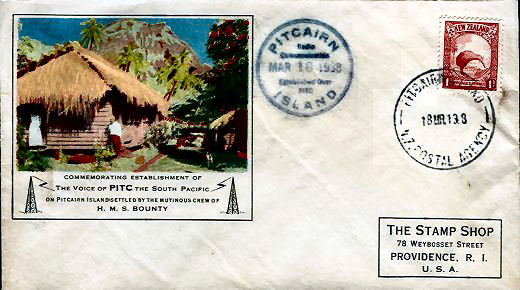![]()
Postal History Introduction
Stampless
Covers
1846
to 1900 Issues
1901-1950
Issues
1951-2003
Issues
Cancels
&
Miscellaneous
Postal
Stationery
Post
Cards
Air
Mail
First
Day &
Event Covers
Parcel Post/Special Delivery
Registered & Official Mail
Commercial & Advertising
Revenue & Postage Due
Wildlife & Game Issues
Complete List of RI Issues
|
Rhode Island Around
the World - International Mail |
|
|
|
|
The cover above is a philatelic cover; that is it was sent for collector purposes and not for the purpose of regular mail. The cover contains a color cachet commemorating the establishment of the radio station PITC on Pitcairn Island. The stamp is the New Zealand 1-pence, copper-red "Kiwi and Cabbage Palm" issue of 1936-1941, (Scott #204). The cover was mailed from Pitcairn Island on March 18, 1938 to The Stamp Shop in Providence, RI. The New Zealand stamp is tied to the cover with a Pitcairn Island Postal Agency Circular Date Stamp (CDS). This cover is what is known as a "Forerunner." The Pitcairn Island Postal Service did not begin issuing stamps until 1940. Pitcairn Island is an isolated volcanic island in the south-central Pacific Ocean. It is located about 1350 miles southeast of Tahiti. It is the only inhabited island in the Pitcairn Group, which also includes Henderson, Ducie and Oeno Islands. Pitcairn is a small island with an area of only 2 square miles. The island is surrounded by high cliffs and raises to a volcanic crater in the center of 1100 feet. The Island was discovered in 1767 by Philip Carteret, a British Naval Officer. The island's current population is descended from the mutineers of the HMS Bounty and the Tahitian maidens that accompanied them to the island. After the mutineers under Fletcher Christian had set Captain Bligh adrift in 1789; they sailed on finally landing on Pitcairn Island in 1790. The island community remained unknown to the rest of the world until 1808 when it was rediscovered by American whalers. The islanders were resettled on Tahiti in 1831 but most later returned to Pitcairn. The island became a regular port of call for whalers and passenger ships sailing between Australia and the United States. In 1856 some of the islanders were relocated to Norfolk Island because of overpopulation. The main town on the island is Adamstown located on the north coast near Bounty Bay and is one of the very few places on the island where small-boats can land. The islanders subsist mainly on fishing and crops, which include sweet potatoes, sugarcane, oranges, bananas and coffee. The sale of postage stamps and carved curios brings in cash income. In 2004, the mayor of the island, Steve Christian and three other islanders were convicted of multiple sex offenses and Christian's sister, Brenda Christian succeeded him as mayor. |
![]()
RI Historical
Society
The Post Offices
Home Page
RI Tercentenary Issue History
RI Philatelic Society
Recently Added Pages
Philatelic Primer
Rhode Island Around the World
Rhode Island
Town Postmarks
Other Websites of Interest
